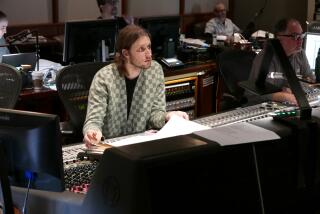Scientist Discovers Genetic Formula for Music
- Share via
When Francis Crick and James Watson unraveled the structure of the DNA molecule more than a quarter of a century ago, little did they know that the genetic blueprint for life also might serve as a source of music.
Not just any music--but melodies that can be likened to the baroque and romantic periods and to austere dissonances reminiscent of 20th-Century composer Igor Stravinsky.
Susumu Ohno, who holds the title of distinguished scientist at the City of Hope Medical Center in Duarte, claims to have discovered what he calls “the primordial secret,” a link between music and the chemistry of genes.
DNA, deoxyribonucleic acid, is the chemical component of genes.
It is responsible for all inherited characteristics of every form of life, determining everything from susceptibility to certain diseases to eye color, height and life span.
By translating the basic chemistry of DNA into musical notes, musicians are performing Ohno’s scores created from cancer genes, genes for antibodies and those that code for enzymes.
When played, a cancer-causing gene called an oncogene sounds somber, slightly out of control.
An enzyme that breaks down lactose--simple milk sugar--sounds like a lullaby. The tune, recorded by a violinist, has been played in several kindergartens in Tokyo and always helps put the children to sleep at nap time, Ohno said.
The melody of a synthetic antibody responsible for detoxifying the chemical compound phenol sounds lively, light-hearted.
“I had no formal training in music,” the reproductive geneticist said. “I knew the basic position of notes but that was all, absolutely nothing more.”
In a scheme he calls periodicity to reflect the repetitious nature of the musical refrain and recurring chemical components of DNA, Ohno hypothesizes that all of nature is characterized by repetition--Earth spinning on its axis, the revolution of planets around the sun.
“Ever since the creation of life on this Earth eons ago, our lives have been dominated by multitudes of periodicities.
“There are nights and days and there are four seasons in the year while the moon waxes and wanes. Even mating calls of song birds have distinct periodicities in the form of repeated melodies.
“It’s very simple,” said Ohno of the process he has created to correlate the basic chemistry of genes to notes of the musical scale.
“The relationship is found between the molecular weights of the purine-pyrimidine bases (the basic chemistry of DNA) and the position of notes on the staff,” he said.
In Ohno’s scheme of linking chemicals to notes, heavier molecular weight molecules assume the lower positions, lighter weight molecules are assigned higher positions.
DNA, which has the appearance of a spiraling ladder, has a distinct chemical composition.
If the helix were to be unwound, the rungs of the ladder would appear as a few repeating units, the purine-pyrimidine bases of which there are only four--adenine, thymine, guanine and cytosine.
Enter Periodicity
“This is where periodicity comes in,” Ohno said of his hypothesis. “The bases always pair in a certain way. Adenine with thymine, guanine with cytosine.
“Since there are only four, you assign two positions each (corresponding to the eight notes of a scale on the musical staff). Once these rules were decided, one could do interesting things,” the geneticist said.
Taking one of 19th-Century composer Frederic Chopin’s nocturnes and translating the notes into a genetic sequence, Ohno found that it surprisingly produced the structure of the enzyme RNA polyerase-II.
Chopin’s “Funeral March” resembles a cancer-causing gene.
In each case, notes of the melody and refrain produce the purine-pyrimidine pairing that occurs naturally in DNA.
Ohno believes that in a basic quantitative way music may be the idiom through which genes one day will be better understood.
Like a Math Problem
“I treat this as I would a mathematical problem. So the relationship between music and DNA isn’t surprising at all. The question I think this poses is why do we like certain melodies?” Ohno said.
He thinks the music of the great composers may have been inherent in their genes and that his system of creating music from genes may have some practical applications for scientists.
“If you want to study, for example, which genes are for certain antibodies, you can look at the sequences and put them into a computer and compare. That’s very boring.
“But what I am hoping, instead, is that one can put them into music and by listening you can figure out what the gene is for.”
Ohno’s work has enlightened scientific thinking on an earlier occasion.
In 1979 he was awarded the Amory Prize for scientific research with his description of the H-Y antigen’s role in mammalian embryonic development. The antigen determines the development of male characteristics.






